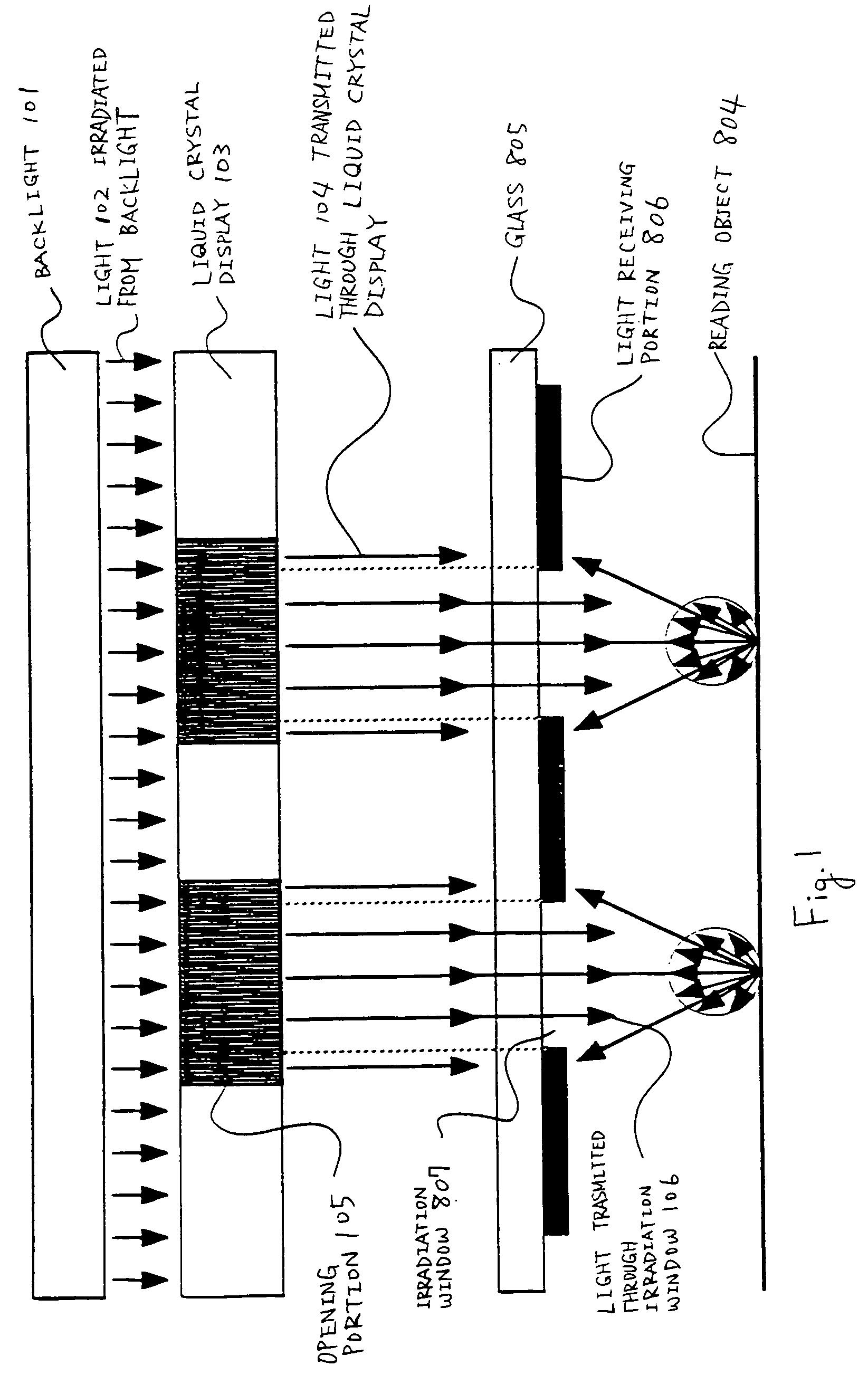Sensor, scanner and portable information terminal each having liquid crystal display
a liquid crystal display and sensor technology, applied in the direction of optical radiation measurement, radiation controlled devices, instruments, etc., can solve the problems of low light utilization efficiency, slow reading speed or mechanical strength, weak signal, etc., and achieve the effect of high light utilization efficiency
- Summary
- Abstract
- Description
- Claims
- Application Information
AI Technical Summary
Benefits of technology
Problems solved by technology
Method used
Image
Examples
embodiment 1
[0106]FIG. 8 shows a view viewing, from above, a case in which a plurality of irradiation windows 807 are provided in a single pixel. FIG. 9 shows a sectional view of FIG. 8 taken along a section line 801. The number of the irradiation windows 807 may be any number so far as the number is a plural number. Glass 805 is formed with light receiving portions 806, circuit portions and the irradiation windows 807. The irradiation window 807 is made to be transparent for transmitting light. According to the light receiving portion 806, a light shielding film is frequently formed between the light receiving portion 806 and the glass 806 such that influence is not effected thereon even when light is incident thereon from a side opposed to a reading object 804. Further, the light receiving portion 806 and the circuit portion may be arranged to overlap.
[0107]Further, although in FIG. 9, for simplicity, only the light receiving portions 806 and the irradiation windows 807 are illustrated on the...
embodiment 2
[0111]FIG. 1 shows a sectional view of a close contact type sensor when a liquid crystal display and a backlight are used as a light source for a sensor. A backlight 101 is provided at the topmost position, a liquid crystal display 103 is provided therebelow, the light receiving portions 806 and the irradiation windows 807 are provided therebelow and the reading object 804 are provided therebelow.
[0112]The glass 805 is formed with the light receiving portions 806, circuit portions and the irradiation windows 807. The irradiation window 807 is made to be transparent for transmitting light. According to the light receiving portion 806, a light shielding film is frequently formed between the light receiving portion 806 and the glass 805 such that influence is not effected thereto even when light is incident from a side opposed to the reading object 804. Further, the light receiving portion 806 and the circuit portion may be arranged to overlap.
[0113]Further, although in FIG. 1, for sim...
example 1
[0121]Next, a description will be given of an example when a plurality of irradiation windows are provided to a single pixel. FIG. 11 shows a circuit diagram of a pixel. In FIG. 11, there is used a photodiode 1104 as a photoelectric conversion element which is an active type sensor. A P-channel side terminal of the photodiode 1104 is connected to a power source reference line 1112 and an N-channel side terminal 1113 thereof is connected to a gate terminal of an amplifying transistor 1106. A drain terminal and a source terminal of the amplifying transistor 1106 are connected to a power source line 1109 and a drain terminal of a switching transistor 1101. Agate terminal of the switching transistor 1101 is connected with a gate signal line 1102 and a source terminal thereof is connected with a signal output line 1103. A gate terminal of a resetting transistor 1107 is connected to a reset signal line 1105. A source terminal and a drain terminal of the resetting transistor 1107 are conne...
PUM
 Login to View More
Login to View More Abstract
Description
Claims
Application Information
 Login to View More
Login to View More - R&D
- Intellectual Property
- Life Sciences
- Materials
- Tech Scout
- Unparalleled Data Quality
- Higher Quality Content
- 60% Fewer Hallucinations
Browse by: Latest US Patents, China's latest patents, Technical Efficacy Thesaurus, Application Domain, Technology Topic, Popular Technical Reports.
© 2025 PatSnap. All rights reserved.Legal|Privacy policy|Modern Slavery Act Transparency Statement|Sitemap|About US| Contact US: help@patsnap.com



